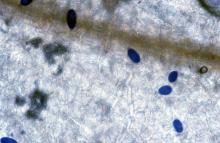See:
Camellia - Flower and Petal Blight
Cause Ovulinia azaleae, a fungus, has been detected in areas west of the Cascade Range. The disease is important on many greenhouse-grown azaleas as well as field-grown rhododendron and azalea. Flowers are the only part of the plant affected. Most azaleas and rhododendrons are susceptible and may become infected if weather and inoculum conditions are favorable. The disease develops during rainy periods at flowering time. It overwinters as sclerotia on diseased petals on plants, on the soil surface, or in leaf mulch under bushes. Sclerotia germinate and give rise to stalked, cup-shaped apothecia. Mature ascospores are discharged from their apothecium. After primary infection, colonization, and the breakdown of flower tissue, numerous conidia form and are spread by splashing rain, insects, and wind. Kalmia flowers are susceptible when grown close to infected Rhododendrons.
Symptoms Infected flowers first show small spots, about 1 mm in diameter, which appear water-soaked. Spots can occur on petals before they are fully open. Spots enlarge rapidly and become slimy. As the disease progress, entire petals become slimy and limp. Infected areas of flowers soon become tan or light brown; eventually entire flowers turn prematurely brown. Infected flowers may last only 2 to 3 days after they are fully opened. Those on lower limbs usually are infected first. Nearly all flowers on a plant become infected when disease conditions are optimum. Infected flowers dry and cling to the plant longer than uninfected flowers. Small, black sclerotia form on infected flowers 8 weeks later. Sclerotia are buried in petal tissue and are most common in the thick portion of the flower throat or tube.
The disease produces no symptoms on the vegetative portion of the plant. Botrytis petal blight causes spots that initially are similar to those of Ovulinia petal blight but do not enlarge as much or as rapidly. Also, Botrytis petal blight does not produce slimy petals.
Cultural control
- Remove and destroy infected flowers. The practice of "deadheading" can be helpful.
- Remove and destroy floral debris from the base of plants or pots. Carefully remove 1 inch of the media, mulch, or soil from around base of plants. Replace with fresh, clean mulch.
- Avoid overhead irrigation.
- Maintain greenhouse humidity below 85%.
- Inspect and isolate any new shipments of plants.
- Pruning will help improve air circulation and drying conditions. Thin dense plantings and/or remove lower branches where first infections are likely to occur.
Chemical control Apply protective fungicides just before floral bud break and then at recommended intervals during the bloom period. Alternate or tank-mix materials from different groups with different modes of action to delay or prevent buildup of resistant fungi. The use of chemicals to inhibit germination of sclerotia and destroying apothecia is possible but not very effective in the long run.
- BioAdvanced Disease Control at 0.75 fl oz/gal water. H
- Bonide Captan 50 WP may be used in home gardens at 1.5 Tbsp/gal water. Washington only. H
- Bonide Fung-onil Multi-purpose Fungicide at 2.25 teaspoons/gal water. Group M5 fungicide. H
- Captan 80 WDG at 1.5 lb/100 gal water. Apply to soil or flowers at 7- to 14-day intervals. Group M4 fungicide. 48-hr reentry.
- Concert at 22 to 35 fl oz/100 gal water. May cause injury to buds, blooms or tender new growth. Landscape use only. Group 3 + M5 fungicide. 12-hr reentry.
- Daconil Weather Stik at 1.38 pints/100 gal water. Apply at 7- to 14-day intervals. Bloom discoloration has been noted on certain cultivars. Group M5 fungicide. 12-hr reentry.
- Eagle 20 EW at 6 to 12 fl oz/100 gal water. Group 3 fungicide. 24-hr reentry.
- Mancozeb-based products. Group M3 fungicides. 24-hr reentry.
- Fore 80 WP at 1.5 lb/100 gal water plus a spreader-sticker.
- Protect DF at 1 to 2 lb/100 gal water plus 2 to 4 oz spreader-sticker.
- Myclobutanil 20 EW T&O at 6 to 12 fl oz/100 gal water plus spreading agent. May observe a PGR effect. Group 3 fungicide. 24-hr reentry.
- Orkestra at 5 to 7 fl oz/100 gal water. Group 7 + 11 fungicide. 12-hr reentry.
- Ortho MAX Garden Disease Control at 2 teaspoons/gal water. H
- Propiconazole-based products. Group 3 fungicides.
- Banner MAXX at 5 to 8 fl oz/100 gal water. 12-hr reentry.
- ProCon-Z at 5 to 8 oz/100 gal water. 24-hr reentry.
- Spectro 90 WDG at 1 to 2 lb/100 gal water. Group 1 + M5 fungicide. 12-hr reentry.
- Spectracide Immunox Multi-Purpose Fungicide Spray Concentrate for Gardens at 1 fl oz/gal water. Group 3 fungicide. H
- Tebuzol 3.6F at 4 to 10 fl oz/100 gal water. Group 3 fungicide. No reentry interval listed.
- Terraclor 400 at 6 to 12 fl oz/100 gal water. Application rate of this solution is based on pot diameter and/or depth of soil, see label for details. Use only as a ground spray under established plants. Do not use hand application equipment unless in the greenhouse. Group 14 fungicide. 12-hr reentry.
- Thiophanate-methyl-based products. Group 1 fungicides. 12-hr reentry.
- Bonide Infuse Systemic Disease Control Lawn and Landscape at 3 lb/1,000 sq ft. Activate with 0.1 to 0.25 inches of water within 24 hours after application. H
- Cleary's 3336 EG at 8 to 16 oz/100 gal water.
- OHP 6672 4.5 F at 10.75 to 20 fl oz/100 gal water.
- Systec 1998 at 20 fl oz/100 gal water. Washington only.
- Torque at 4 to 10 fl oz/100 gal water. Use 2 to 3 times per week into the flowers as they open. Group 3 fungicide. 12-hr reentry.
- Ziram 76 DF at 1.5 to 2 lb/100 gal water. Group M3 fungicide. 48-hr reentry.
Reference Peterson, J.L. and Davis Jr, S.H. 1977. Effect of fungicides and application timing on control of azalea petal blight. Plant Disease Reporter 61:209-212.


